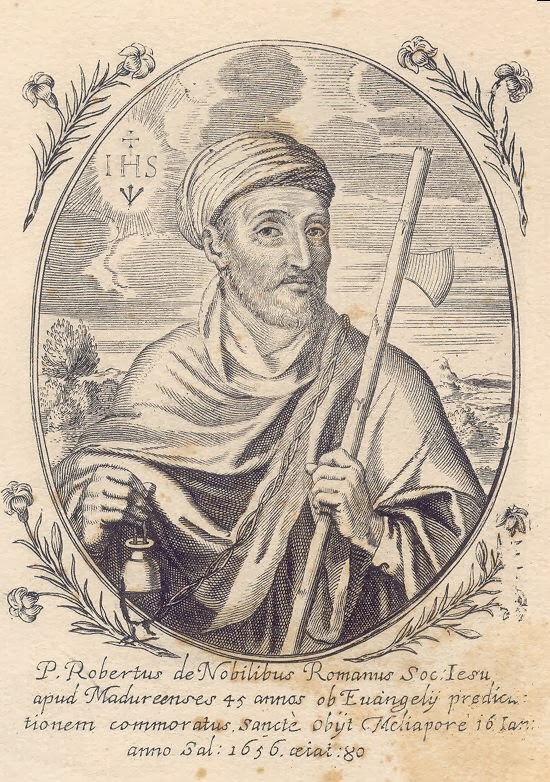1. Background and early influences
Roberto Nobili was born in 1577 in Tuscany, Italy. His family was part of the Italian aristocracy and had close connections with the Roman Catholic church hierarchy. To the disappointment of his family, Nobili did not pursue high office in the church, instead opting to join the Society of Jesus. He was an excellent scholar under Jesuit instruction and he became deeply established in Counter-Reformation orthodoxy and Thomistic rationality. Nobili presented himself for missionary service and sailed for India in 1605.
2. The context of Nobili’s missionary work
Nobili joined the Portuguese missionary Father Goncales in Madurai, South India, in 1606. Madurai was the centre of Tamil culture and language, and a university town where thousands of Brahmans (high-caste Hindus) flocked to receive instruction in Hindu thought. Converts to Christianity had come only from low-caste Indians.
Missionary work amongst the high castes was nullified by a cultural stand-off in which both the Portuguese (known as parangis) and the Indians considered their own ways infinitely superior to those of the other. The missionaries had accepted the term parangi and identified conversion with entry into the parangi community. Scandalised as they were by filthy parangi ways such as the wearing of leather shoes, eating with a knife and fork, drinking wine, and eating beef, high-caste Hindus would have nothing to do with it. Nobili, distressed by the absence of Brahman converts, pioneered an adventurous new way through this impasse for the Christian message as he understood it.
3. Methods used in presenting his message and planting the church
3.1 Cultural adaptation
Nobili believed the caste system to be simply a mark of classical hierarchical society, in principle just like his own Italian society. To him, Indian society was therefore inherently compatible with Christianity just as Rome was, and did not need “civilising” as other missionaries believed. Nobili worked within the caste system, seeking to “incarnate” Christ in Brahman form. With his Tamil language teacher as his informant, Nobili conformed as far as possible to the lifestyle of the Brahmans. He took on the identity of a sannyasi (renunciant holy man), found residence in a high-caste (but probably not Brahman) part of the city and ceased all contact with those of low-caste, including Christians. Nobili became fluent in Tamil, Telugu and Sanskrit.
3.2 Evangelism through disputation
Having “entered” Brahman society, Nobili began to engage in discussions with Brahmans on matters such as the unity of God, creation, karma and the soul. He made a thorough study of the Hindu scriptures, and was probably the first European to do so. Nobili held to the concept of “universal reason” as the foundation of all good societies and true religious doctrine wherever they may be found. He considered Hindu concepts such as dharma (ethics and morality) to be an expression of universal reason, and therefore preparation for the gospel. However, the concept of karma he considered to be an irrational erosion of true religion.
Nobili’s fully developed method was to dispute with learned Hindus in ways familiar to them, clear away irrationality and superstitions, and establish thoroughly orthodox Catholic doctrine as if it were not really new to them. The ground thus prepared, he would present Christ as a satguru who teaches the true way to heaven by his holy life, and who suffers and makes satisfaction for sins.
3.3 Accommodation – A church for high-caste Hindus
Nobili’s arguments proved persuasive to some, and by Easter 1609 there were fifty high-caste converts. Nobili believed that caste was a civil institution with no necessary religious significance. Consequently, he did not require converts to abandon any of the trappings of their caste except for idolatrous practices. They retained their distinctive tufts of hair, and the sacred cords of twice-born Brahmans, and did not associate with those of low-caste including Christians. Nobili had a church built for them but no Indians were put forward for priesthood. In consultation with his bishop, he made some accommodating changes to Catholic practice and liturgy. Facing opposition from other missionaries, Nobili won papal approval for his approach and his converts proved themselves orthodox Catholics.
Nobili perpetuated his work by having other missionaries adopt the sannyasi code, and writing down his method of disputation and instruction of converts. By 1643 there had been 600 high-caste converts. While numbers were small compared to the thousands of low-caste converts at Madurai, this was a significant achievement Nobili died in Mylapore in 1656 and the Madurai Mission ended in 1759.
4. Lessons for missions today
The case of Nobili has lessons even for Protestant and evangelical missions today. Nobili’s work demonstrates the need for adaptation and accommodation in mission. Unnecessary barriers to the Gospel may be removed when missionaries live within the culture of their hosts, give serious attention to their religion and vernacular, and present Christianity as much as possible in local terms.
However, the adapting missionary must deal with issues of transparency and plainness. Nobili’s mission depended greatly on the success of his Brahman ‘disguise’, and evasive tactics were employed to dissociate from the parangis.
The difficult task of distinguishing the properly universal from particular cultural and religious detail complicates the process of accommodation. Nobili imposed a Western philosophical framework that led him to underestimate the religious significance of caste and ignore the possibility of sociological change.
Nevertheless, Nobili’s work has had a lasting influence on mission in South India and his approach anticipates later ideas on inculturation.
